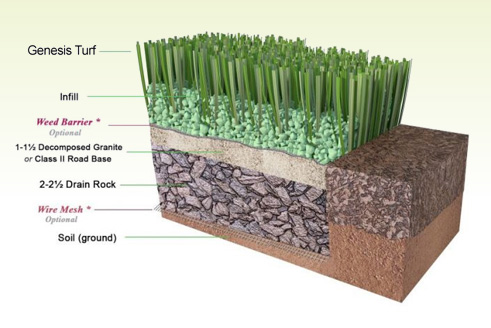Look Into the Environmental Conveniences of Opting for Artificial Turf Solutions
The adoption of artificial lawn remedies presents a compelling opportunity to deal with pressing ecological obstacles. By dramatically reducing water usage and reducing the application of damaging chemicals, these choices not only advertise lasting landscape design however likewise safeguard regional environments.
Water Conservation Advantages
One of the most significant advantages of artificial turf is its capacity to conserve water. In comparison, synthetic lawn does not require watering, significantly reducing the general need for water sources.
By getting rid of the demand for routine watering, synthetic grass contributes to lasting landscape practices and assists minimize the environmental influence of extreme water consumption. The conservation of water prolongs to the decrease of overflow, which can lead to dirt erosion and river contamination.
In addition, the installation of synthetic lawn enables communities and home owners to allot water sources a lot more effectively, concentrating on crucial usages such as alcohol consumption water and agriculture. The shift towards synthetic grass not just advertises accountable water usage yet also lines up with wider ecological objectives targeted at preserving natural resources.
As neighborhoods progressively focus on sustainability, the water preservation advantages of synthetic grass present an engaging situation for its fostering in property and commercial landscaping jobs.
Decreased Chemical Usage
The shift to man-made grass considerably lowers the reliance on chemical therapies typically used in natural turf maintenance. Typical lawn monitoring normally entails the application of chemicals, fertilizers, and herbicides to advertise growth and control bugs. These chemicals can position threats to human health and wellness, local wildlife, and the environment, adding to soil and water contamination.
In comparison, artificial turf gets rid of the requirement for these harmful compounds. By reducing the release of artificial compounds right into the ecological community, fabricated lawn advertises healthier soil and water systems.
Furthermore, the lack of chemical drainage related to synthetic grass setups aids protect local rivers from contamination, sustaining water life and maintaining biodiversity. Turf installation phoenix az. As areas progressively prioritize lasting methods, selecting man-made turf offers a feasible service that straightens with ecological preservation goals. Via this shift, homeowner can take pleasure in lavish green areas without compromising environmental wellness, leading the method for an extra lasting future
Lower Carbon Footprint

Furthermore, the setup of synthetic lawn can cause significant water preservation. All-natural yards require considerable quantities of water for watering, which not only includes in the carbon footprint related to water extraction and therapy however also pressures local water resources. In comparison, synthetic grass requires very little upkeep, requiring no watering, thereby significantly reducing water use and its connected energy costs.
Additionally, the longevity of fabricated turf great post to read adds to its reduced carbon influence. With a life-span of as much as 15 look at more info years or more, the demand for regular replacements is diminished, leading to much less waste and reduced energy usage in production and taking care of traditional turf alternatives. Generally, artificial grass provides a sustainable option for environmentally mindful landscaping.
Environment Conservation
Habitat preservation is a vital factor to consider in the debate over landscaping options, specifically when comparing synthetic lawn to natural yard. Natural grass yards often require considerable upkeep, consisting of making use of fertilizers, chemicals, and herbicides, which can negatively affect local ecosystems. These chemicals can leach into the soil and waterways, hurting indigenous flora and animals and interfering with regional environments.
Artificial lawn removes the requirement for damaging chemicals, thus shielding nearby wild animals and maintaining the stability of bordering communities. The setup of synthetic grass can lead to the conversion of previous turf locations right into more biodiverse landscapes, such as pollinator yards or native plant locations, which can sustain regional wild animals.
Inevitably, the transition to synthetic grass not just saves water and decreases upkeep initiatives but likewise fosters an extra unified partnership in between human activities and the natural surroundings, advertising environment preservation while doing so.
Long-Term Sustainability
Long-term sustainability is an important consider assessing the benefits of synthetic grass over conventional lawn yards. Among the most considerable benefits of synthetic grass is its longevity; it can last up to 15-20 years with minimal maintenance, whereas natural yard calls for frequent reseeding and replacement. This long life minimizes the demand for constant resources, such as water, plant foods, and pesticides, which are crucial for maintaining a healthy grass yard.
Additionally, synthetic grass adds to a reduction in carbon exhausts related to yard care devices. Standard yards usually call for gas-powered lawn mowers, leaners, and blowers, all of which add to air contamination. Arizona turf. In contrast, artificial turf eliminates the need for such tools, advertising a cleaner atmosphere
Furthermore, the manufacturing of man-made turf increasingly makes use of recycled products, boosting its sustainability profile. As producers embrace green methods, the environmental impact of synthetic grass remains to diminish.

Verdict
The adoption of artificial go to this web-site turf remedies provides considerable environmental advantages, including substantial water preservation, decreased reliance on dangerous chemicals, and a reduced carbon impact. Man-made grass aids in maintaining natural habitats by minimizing land disturbance and promoting long-term sustainability with the usage of durable products. Jointly, these variables emphasize the capacity of artificial turf to contribute favorably to ecological health and wellness and offer a sensible option to traditional landscape design methods in an increasingly resource-conscious globe.
In comparison, artificial grass does not need watering, considerably decreasing the general demand for water resources. By decreasing the launch of synthetic substances right into the ecosystem, fabricated lawn advertises healthier dirt and water systems.
Moreover, the setup of fabricated grass can result in substantial water preservation. In contrast, synthetic turf needs minimal upkeep, calling for no watering, thereby considerably reducing water use and its linked energy expenses.
